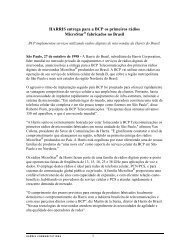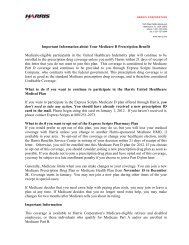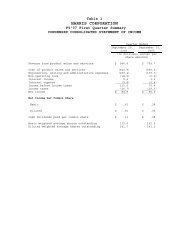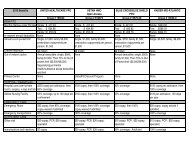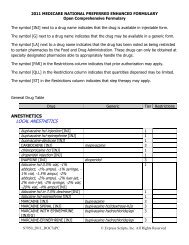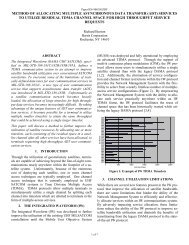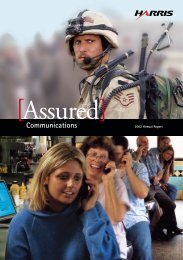harris corporation
harris corporation
harris corporation
Create successful ePaper yourself
Turn your PDF publications into a flip-book with our unique Google optimized e-Paper software.
Networking Wideband Waveform (“ANW2”) for high bandwidth data operation and is designed for future upgrade<br />
to the JTRS Soldier Radio Waveform (“SRW”). The 117G’s wideband network access capabilities give warfighters<br />
and field commanders critical real-time information. The 117G has been deployed to all branches of the DoD and is<br />
being used in a wide variety of ground, vehicular and airborne applications, including intelligence, surveillance and<br />
reconnaissance (“ISR”). The 117G includes a Remote Operated Video Enhanced Receiver (“ROVER”) interoperable<br />
mode that provides warfighters on the battlefield with the ability to receive live video directly from unmanned aerial<br />
vehicles (“UAVs”). This capability allows users to receive video feeds directly from UAVs without an intermediary<br />
or having to pass that information from a base station.<br />
Our cryptographic solutions encompass NSA-certified products and systems that range from single integrated<br />
circuits to major communications systems, including our Sierra» and Citadel» embedded encryption solutions and<br />
KGV-72 blue force tracking programmable encryption devices and our SecNet 11» and SecNet 54 TM Internet<br />
Protocol (“IP”) communications families of communications security (“COMSEC”) terminals.<br />
In the international market, our tactical radios are the standard of NATO and Partnership for Peace countries<br />
and have been sold to more than 100 countries through our strong, longstanding international distribution channels<br />
consisting of regional sales offices and a broad dealer network. International tactical radio demand is being driven<br />
by continuing tactical communications modernization and standardization programs to provide more sophisticated<br />
communications capabilities to address traditional and emerging threats and to provide interoperability. In fiscal<br />
2011, we received tactical radio orders from, and/or made deliveries to, a wide range of international customers,<br />
including Afghanistan, Australia, Brazil, Canada, Mexico and various countries in Africa, Asia and Southeast Asia<br />
that we are not permitted to name. Additionally, we are providing integrated communications systems for the<br />
international market. Our integrated systems offerings are largely based on our products, but include other<br />
companies’ products, as well as a wide variety of applications, in order to implement integrated command, control,<br />
communications, computers, intelligence, surveillance and reconnaissance (“C4ISR”) systems for many different<br />
types of platforms, including command post and transit case systems, vehicular and shelter communications systems<br />
and specialized airborne applications, which are frequently used in border security and surveillance systems.<br />
Public Safety and Professional Communications: We supply assured communications» systems and equipment<br />
for public safety, federal, utility, commercial and transportation markets, with products ranging from complete<br />
end-to-end wireless network infrastructure solutions, including advanced IP voice and data networks, that support<br />
multiple platforms and provide interoperability among disparate systems, to portable and mobile single-band and<br />
multiband, multimode radios, to public safety-grade broadband voice, video and data solutions. On May 29, 2009,<br />
we acquired substantially all of the assets of the Tyco Electronics wireless systems business (“Wireless Systems”)<br />
(formerly known as M/A-COM). Our acquisition of Wireless Systems served to form our Public Safety and<br />
Professional Communications business. This business has more than 80 years of experience and supports over<br />
500 systems around the world.<br />
As part of our business of designing, building, distributing, maintaining and supplying wireless communications<br />
systems, we offer our Voice, Interoperability, Data and Access (“VIDA”) network platform — a unified IP-based<br />
voice and data communication system based on APCO P25 industry standards that provides network-level<br />
interoperable communications among public safety agencies and that supports a full line of communications<br />
systems, including OpenSky», NetworkFirst, P25 IP and Enhanced Digital Access Communication System<br />
(“EDACS”), allowing seamless interconnection of diverse systems. Our VIDA network solutions currently serve as<br />
the backbone in some of the largest and most advanced statewide and regional communications networks in North<br />
America, including the Commonwealth of Pennsylvania and State of Florida.<br />
In addition to a full range of single-band land mobile radio terminals, we offer our Unity TM family of multiband<br />
radios, including the Unity XG-100P handheld radio and the new Unity XG-100M full-spectrum mobile radio for<br />
vehicles. Our Unity multiband radios cover all public safety frequency bands in a single radio; operate on APCO<br />
P25 conventional and trunked systems; are backwards compatible with analog FM systems; and include advanced<br />
capabilities, such as an internal Global Positioning System (“GPS”) receiver for situational awareness, internal<br />
secure Bluetooth» wireless technology, and background noise suppression features. They also include true softwaredefined<br />
radio architecture that allows flexibility for future growth, including a software-only upgrade to APCO P25<br />
Phase 2, the next-generation emerging standard for mission-critical communications. Our Unity radios’ multiband,<br />
multi-mode capabilities enable a single radio to communicate with multiple organizations, jurisdictions and agencies<br />
operating on different frequencies and systems, thus providing a significant improvement over most current radio<br />
systems for U.S. public safety, which are not interoperable and thus require users to carry multiple radios or route<br />
transmissions through ad-hoc network bridges, often configured at the time of an emergency, and resulting in<br />
instances where agencies responding to a common incident cannot talk to each other.<br />
4




